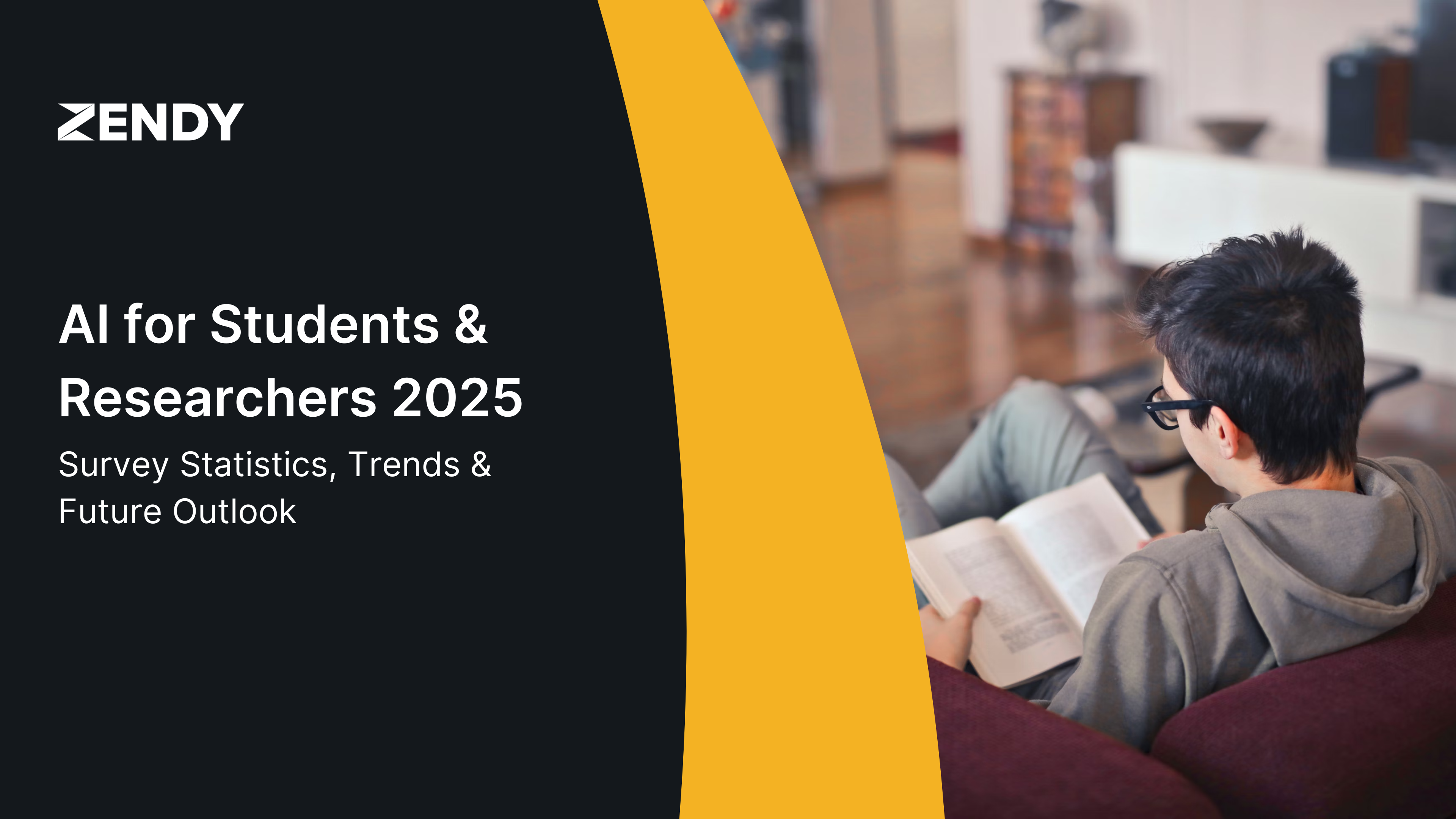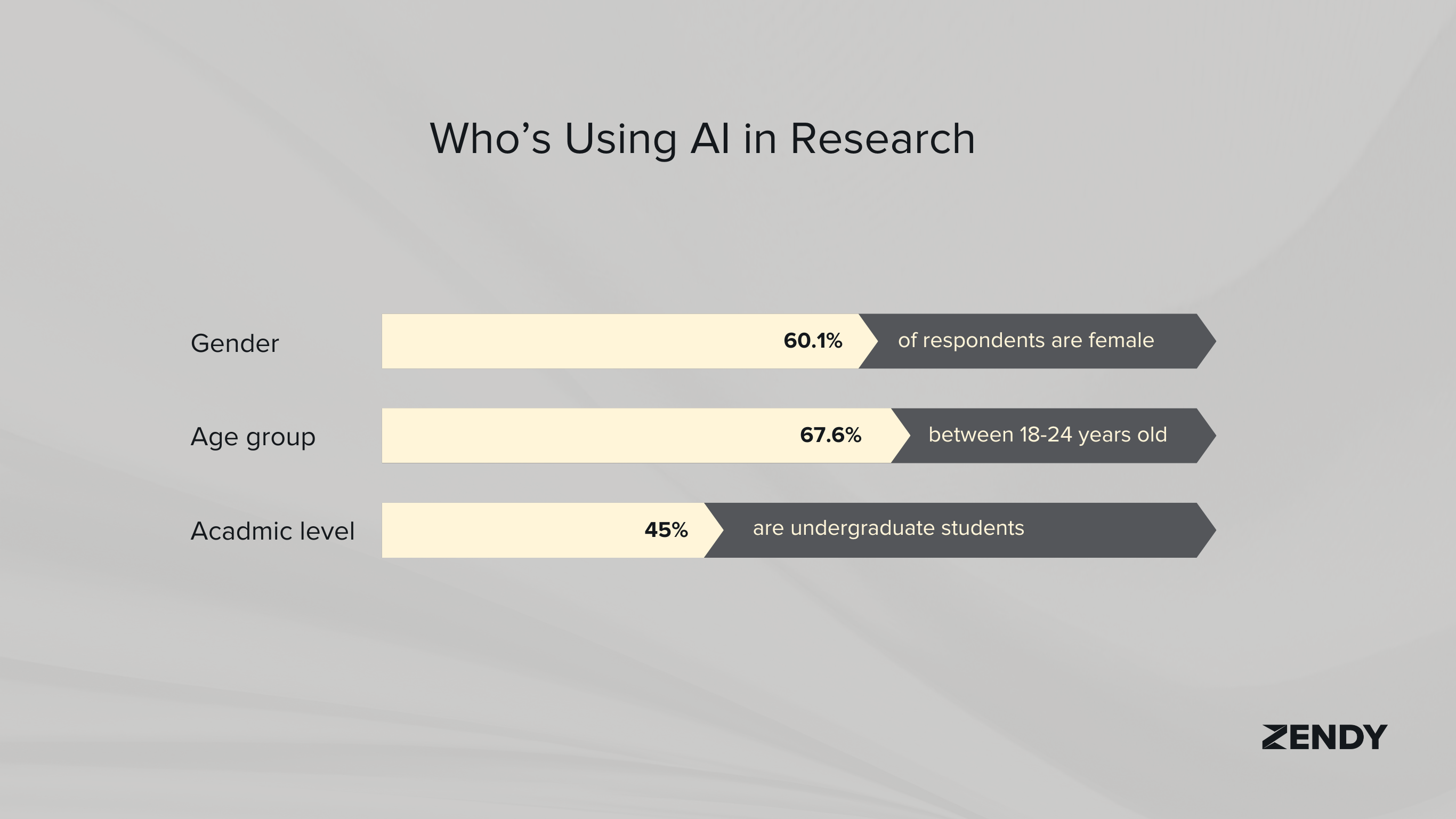AI in Education for Students and Researchers: 2025 Trends and Statistics
With millions of scholarly content published every year, in addition to the integration of Artificial Intelligence (AI) into various fields in the past few years, including the educational sector, AI in education has had, and still, a major impact on simplifying research projects, accelerating discoveries, and optimising learning experiences. Giving students and researchers the chance to work efficiently and effectively more than ever. So, how much time do researchers spend on repetitive tasks that AI can simplify?

On the other side of the story, The global market for AI in education was estimated to be worth $2.5 billion in 2022 and is expected to more than double by 2025, according to the most recent data from AIPRM. However, how exactly are researchers using AI, and what are the challenges they face?
This means that Artificial Intelligence (AI) is changing every aspect of modern life, including education and research. It’s reshaping how students learn, how researchers solve problems, and how educators teach. According to our latest survey, 73.6% use AI in education, 51% use it for literature review and 46.3% of students and researchers are using AI in education for writing and editing, showing just how quickly these tools are being adopted.
AI in education helps by sorting through the tremendous amount of scientific information, analysing large datasets of structured or unstructured data, and spotting connections that might take months to find manually. It also takes care of time-consuming tasks like summarising studies and formatting citations, so researchers can focus on bigger questions. With so much information and so little time, AI isn’t just helpful, it’s becoming a necessity.
Zendy surveyed more than 1,500 students and researchers to understand how they use AI tools. The study shows how people incorporate AI into their academic work, the benefits they find most useful, and the challenges they face. The findings give a clearer picture of AI’s role in academic work and its impact on productivity.

Click download to access the full report
Demographics of AI Users in Research
Zendy’s study provides insights into who is using AI in education. Most respondents are young learners, early in their academic journey, which gives us a sense of tools and support they’re looking for.
- 60.1% of respondents are female, 36% are male while the rest prefer not to disclose.
- 67.6% are between 18-24 years old, reflecting early-career researchers and students.
- 45% are undergraduate students, 37.2% are high school students, exploring AI tools for learning and research

Click download to access the full report
Habits and AI in Education Adoption
Students and researchers are highly engaged in academic literature and are shifting toward AI-driven tools for efficiency. Zendy's survey reveals how dedicated students and researchers are to expanding their knowledge and staying current in their fields. Regularly engaging with academic literature is a key part of their studies and professional growth, reflecting the effort they invest in learning.
The survey also shows a clear preference for online databases, highlighting a growing reliance on digital tools for easy access to research materials. This shift points to a broader move toward more convenient and centralised platforms, supported by the use of responsible AI and other technologies in academic work. These findings underline the importance of user-friendly, well-resourced tools that meet the changing needs of today’s learners and professionals.
- 71.5% read research papers daily or several times a week, indicating high engagement
- 49.3% of respondents spend an average of 4.5 hours each day engaging with research papers
- 50% prefer online databases for accessing research articles, reflecting the growing digitisation of academic research.

Click download to access the full report
How is AI Being Used in Research?
The study highlights how AI in education is transforming scholarly content practices, with more researchers using it in their daily routines. One of the most common uses is for literature reviews, traditionally a time-consuming task that AI is helping to make faster and more manageable. The findings show a willingness to embrace AI and point to key areas where it can have an even greater impact, especially in literature reviews, writing, and editing.
- 73.6% have used or are exploring AI tools for research.
- 51% use AI for literature reviews.
- 46.3% for writing and editing, highlighting key areas for AI development
These findings indicate a widespread acceptance of AI in education and a growing demand for AI-powered tools.

Click download to access the full report
Accessibility and Device Preferences
With research becoming increasingly digital, the choice of devices used for academic work is evolving, most users still rely on desktops for research, and more researchers are turning to mobile devices. This shift highlights the need to focus on making mobile access smoother and more user-friendly, all while ensuring that the desktop experience remains just as reliable and effective.
- 57.9% prefer desktops valuing stability and a larger screen.
- 34.8% prefer mobile devices for reading research, emphasising convenience and portability.
- 7.3% prefer tablets.
This trend highlights the need for mobile-friendly AI-powered research platforms while maintaining robust desktop experiences.

Click download to access the full report
Impact of AI in Education
Finally, researchers were asked about their perception of AI’s effectiveness in academic work. Over half of the respondents shared they consider AI tools to be highly effective, particularly for simplifying complex tasks. Many highlighted how impactful these tools are in saving hours and making the research journey more efficient, showing just how valuable AI has become in the academic sector.
- 39.6% find it very effective
- 33.4% find it effective
- 21.8% are neutral
- 3.7% think it’s ineffective
- 1.5% think it’s very ineffective
The overwhelming majority see AI as a valuable tool, streamlining research and saving time.

Click download to access the full report
Ethical Concerns & AI Limitations
AI offers many benefits, but there are still some ethical issues to work through:
- Bias and Accuracy – AI in education can reflect biases in the data it’s trained on, which can lead to misleading results.
- Ethical Concerns – Researchers need to make sure AI-generated content meets academic integrity standards.
- Cost and Access – Some AI tools are expensive, making them harder to access for students and researchers with limited resources.
To address these AI ethical issues, educators, researchers, and technology providers need to work together to ensure AI is used responsibly in academia.
The Future of AI in Education
AI in education is evolving rapidly, and the trends from Zendy’s survey suggest where it’s headed next.
With 73.6% of respondents already using AI in education, its role will only expand. One of the biggest areas of growth is predictive analysis, where AI is expected to help researchers spot patterns in massive datasets—an extension of how AI is already streamlining literature reviews and data organisation today.
Collaboration is another key area. As AI in education tools become more sophisticated, they will help researchers across different disciplines and countries work together more efficiently, reducing language barriers and improving access to global knowledge.
As AI technology advances, its impact on academic research will deepen, offering both opportunities and challenges. The focus now is on ensuring these tools remain accessible, ethical, and aligned with researchers’ real needs.
Finally, AI in education is set to transform experimentation and simulations. Innovations in AI-driven modelling, combined with augmented and virtual reality, could make complex experiments more interactive, accurate, and scalable.
Conclusion
The survey offers a closer look at how AI is undeniably shaping the future of education, specially scientific research, helping students and researchers work more efficiently. From automating literature reviews to improving writing and editing, it’s clear that AI in education is becoming an indispensable part of academic workflows. However, challenges like affordability and accessibility remain key areas to address, ensuring that AI-powered research tools remain accessible and fair for everyone.
At Zendy, we are committed to developing AI-driven tools that cater to the real needs of students, researchers, and professionals.
Download the full report to learn about the methodology behind our findings, explore deeper insights into AI in education, and discover how it’s shaping the academic world.
Click download to access the full report

Research Integrity, Partnership, and Societal Impact
Research integrity extends beyond publication to include how scholarship is discovered, accessed, and used, and its societal impact depends on more than editorial practice alone. In practice, integrity and impact are shaped by a web of platforms and partnerships that determine how research actually travels beyond the press. University press scholarship is generally produced with a clear public purpose, speaking to issues such as education, public health, social policy, culture, and environmental change, and often with the explicit aim of informing practice, policy, and public debate. Whether that aim is realised increasingly depends on what happens to research once it leaves the publishing workflow. Discovery platforms, aggregators, library consortia, and technology providers all influence this journey. Choices about metadata, licensing terms, ranking criteria, or the use of AI-driven summarisation affect which research is surfaced, how it is presented, and who encounters it in the first place. These choices can look technical or commercial on the surface, but they have real intellectual and social consequences. They shape how scholarship is understood and whether it can be trusted beyond core academic audiences. For university presses, this changes where responsibility sits. Editorial quality remains critical, but it is no longer the only consideration. Presses also have a stake in how their content is discovered, contextualised, and applied in wider knowledge ecosystems. Long-form and specialist research is particularly exposed here. When material is compressed or broken apart for speed and scale, nuance can easily be lost, even when the intentions behind the system are positive. This is where partnerships start to matter in a very practical way. The conditions under which presses work with discovery services directly affect whether their scholarship remains identifiable, properly attributed, and anchored in its original context. For readers using research in teaching, healthcare, policy, or development settings, these signals are not decorative. They are essential to responsible use. Zendy offers one example of how these partnerships can function differently. As a discovery and access platform serving researchers, clinicians, and policymakers in emerging and underserved markets, Zendy is built around extending reach without undermining trust. University press content is surfaced with clear attribution, structured metadata, and rights-respecting access models that preserve the integrity of the scholarly record. Zendy works directly with publishers to agree how content is indexed, discovered, and, where appropriate, summarised. This gives presses visibility into and control over how their work appears in AI-supported discovery environments, while helping readers approach research with a clearer sense of scope, limitations, and authority. From a societal impact perspective, this matters. Zendy’s strongest usage is concentrated in regions where access to trusted scholarship has long been uneven, including parts of Africa, the Middle East, and Asia. In these contexts, university press research is not being read simply for academic interest. It is used in classrooms, clinical settings, policy development, and capacity-building efforts, areas closely connected to the Sustainable Development Goals. Governance really sits at the heart of this kind of model. Clear and shared expectations around metadata quality, content provenance, licensing boundaries, and the use of AI are what make the difference between systems that encourage genuine engagement and those that simply amplify visibility without depth. Metadata is not just a technical layer: it gives readers the cues they need to understand what they are reading, where it comes from, and how it should be interpreted. AI-driven discovery and new access models create real opportunities to broaden the reach of university press publishing and to connect trusted scholarship with communities that would otherwise struggle to access it. But reach on its own does not equate to impact. When context and attribution are lost, the value of the research is diminished. Societal impact depends on whether work is understood and used with care, not simply on how widely it circulates. For presses with a public-interest mission, active participation in partnerships like these is a way to carry their values into a more complex and fast-moving environment. As scholarship is increasingly routed through global, AI-powered discovery systems, questions of integrity, access, and societal relevance converge. Making progress on shared global challenges requires collaboration, shared responsibility, and deliberate choices about the infrastructures that connect research to the wider world. For university presses, this is not a departure from their mission, but a continuation of it, with partnerships playing an essential role. FAQ How do platforms and partnerships affect research integrity?Discovery platforms, aggregators, and technology partners influence which research is surfaced, how it’s presented, and who can access it. Choices around metadata, licensing, and AI summarization directly impact understanding and trust. Why are university press partnerships important?Partnerships allow presses to maintain attribution, context, and control over their content in discovery systems, ensuring that research remains trustworthy and properly interpreted. How does Zendy support presses and researchers?Zendy works with publishers to surface research with clear attribution, structured metadata, and rights-respecting access, preserving integrity while extending reach to underserved regions. For partnership inquiries, please contact: Sara Crowley Vigneau Partnership Relations Manager Email: s.crowleyvigneau@zendy.io .wp-block-image img { max-width: 65% !important; margin-left: auto !important; margin-right: auto !important; }

Beyond Publication. Access as a Research Integrity Issue
If research integrity now extends beyond publication to include how scholarship is discovered and used, then access is not a secondary concern. It is foundational. In practice, this broader understanding of integrity quickly runs into a hard constraint: access. A significant percentage of academic publishing is still behind paywalls, and traditional library sales models fail to serve institutions with limited budgetsor uneven digital infrastructure. Even where university libraries exist, access is often delayed or restricted to narrow segments of the scholarly record. The consequences are structural rather than incidental. When researchers and practitioners cannot access the peer-reviewed scholarship they need, it drops out of local research agendas, teaching materials as well as policy conversations. Decisions are then shaped by whatever information is most easily available, not necessarily by what is most rigorous or relevant. Over time, this weakens citation pathways, limits regional participation in scholarly debate, and reinforces global inequity in how knowledge is visible, trusted, and amplified. The ongoing success of shadow libraries highlights this misalignment: Sci-Hub reportedly served over 14 million monthly users in 2025, indicating sustained and widespread demand for academic research that existing access models continue to leave unmet. This is less about individual behaviour than about a system that consistently fails to deliver essential knowledge where it is needed most. The picture looks different when access barriers are reduced: usage data from open and reduced-barrier initiatives consistently show strong engagement across Asia and Africa, particularly in fields linked to health, education, social policy, and development. These patterns highlight how emerging economies rely on high-quality publishing in contexts where it directly impacts professional practice and public decision-making. From a research integrity perspective, this is important. When authoritative sources are inaccessible, alternative materials step in to fill the gap. The risk is not only exclusion, but distortion. Inconsistent, outdated, or unverified sources become more influential precisely because they are easier to obtain. Misinformation takes hold most easily where trusted knowledge is hardest to reach. Addressing access is about more than widening readership or improving visibility, it is about ensuring that high-quality scholarship can continue to shape understanding and decisions in the contexts it seeks to serve. For university presses committed to the public good, this challenge sits across discovery systems, licensing structures, technology platforms, and the partnerships that increasingly determine how research is distributed, interpreted, and reused. If research integrity now extends across the full lifecycle of scholarship, then sustaining it requires collective responsibility and shared frameworks. How presses engage with partners, infrastructures, and governance mechanisms becomes central to protecting both trust and impact. FAQ: What challenges exist in current access models?Many academic works remain behind paywalls, libraries face budget and infrastructure constraints, and access delays or restrictions can prevent researchers from using peer-reviewed scholarship effectively. What happens when research is inaccessible?When trusted sources are hard to reach, alternative, inconsistent, or outdated materials often fill the gap, increasing the risk of misinformation and weakening citation pathways. How does Zendy help address access challenges?Zendy provides affordable and streamlined access to high-quality research, helping scholars, practitioners, and institutions discover and use knowledge without traditional barriers. For partnership inquiries, please contact:Sara Crowley VigneauPartnership Relations ManagerEmail:s.crowleyvigneau@zendy.io .wp-block-image img { max-width: 65% !important; margin-left: auto !important; margin-right: auto !important; }

Beyond Peer Review. Research Integrity in University Press Publishing
University presses play a distinctive role in advancing research integrity and societal impact. Their publishing programmes are closely aligned with public-interest research in the humanities, social sciences, global health, education, and environmental studies, disciplines that directly inform policy and progress toward the UN Sustainable Development Goals. This work typically prioritises depth, context, and long-term understanding, often drawing on regional expertise and interdisciplinary approaches rather than metrics-driven outputs. Research integrity is traditionally discussed in terms of editorial rigour, peer review, and ethical standards in the production of scholarship. These remain essential. But in an era shaped by digital platforms and AI-led discovery, they are no longer sufficient on their own. Integrity now also depends on what happens after publication: how research is surfaced, interpreted, reduced, and reused. For university presses, this shift is particularly significant. Long-form scholarship, a core strength of press programmes, is increasingly encountered through abstracts, summaries, extracts, and automated recommendations rather than sustained reading. As AI tools mediate more first encounters with research, meaning can be subtly altered through selection, compression, or loss of context. These processes are rarely neutral. They encode assumptions about relevance, authority, and value. This raises new integrity questions. Who decides which parts of a work are highlighted or omitted? How are disciplinary nuance and authorial intent preserved when scholarship is summarised? What signals remain to help readers understand scope, limitations, or evidentiary weight? This isn’t to say that AI-driven discovery is inherently harmful, but it does require careful oversight. If university press scholarship is to continue informing research, policy, and public debate in meaningful ways, it needs to remain identifiable, properly attributed, and grounded in its original framing as it moves through increasingly automated discovery systems. In this context, research integrity extends beyond how scholarship is produced to include how it is processed, surfaced and understood. For presses with a public-interest mission, research integrity now extends across the full journey of a work, from how it is published to how it is discovered, interpreted and used. FAQ Can Zendy help with AI-mediated research discovery?Yes. Zendy’s tools help surface, summarise, and interpret research accurately, preserving context and authorial intent even when AI recommendations are used. Does AI discovery harm research, or can it be beneficial?AI discovery isn’t inherently harmful—it can increase visibility and accessibility. However, responsible use is essential to prevent misinterpretation or loss of nuance, ensuring research continues to inform policy and public debate accurately. How does Zendy make research more accessible?Researchers can explore work from multiple disciplines, including humanities, social sciences, global health, and environmental studies, all in one platform with easy search and AI-powered insights. For partnership inquiries, please contact:Sara Crowley Vigneau Partnership Relations Manager Email: s.crowleyvigneau@zendy.io .wp-block-image img { max-width: 65% !important; margin-left: auto !important; margin-right: auto !important; }
Address
John Eccles HouseRobert Robinson Avenue,
Oxford Science Park, Oxford
OX4 4GP, United Kingdom
